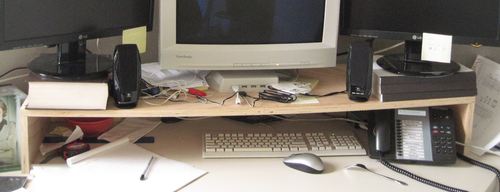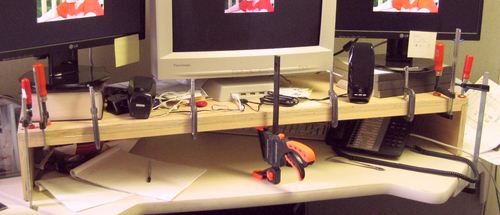Fixing a sagging plywood shelf
 A co-worker had built himself a stand for his monitors out of plywood
a few years ago. But over time, the unsupported plywood, and under the
weight of a 21" CRT monitor, developed a bothersome sag,
and he asked me if I could fix it. I couldn't say no to the challenge!
A co-worker had built himself a stand for his monitors out of plywood
a few years ago. But over time, the unsupported plywood, and under the
weight of a 21" CRT monitor, developed a bothersome sag,
and he asked me if I could fix it. I couldn't say no to the challenge!
 I fixed the sag by gluing a piece of pine to the bottom edge of the plywood. The
piece of pine was about 15 cm wide, and 16 mm thick - not quite as thick as the actual plywood
itself. By gluing on this piece, the plywood and the board would act as a much
thicker and stiffer support. Stiffness to bending increases with thickness raised
to the power of three, so by nearly doubling the thickness near the front edge,
stiffness would go up a lot. Pieces laminated together like that tend to hold their
shape once the glue is dried. So what I was doing here was sort of like
a very crude bent lamination
I fixed the sag by gluing a piece of pine to the bottom edge of the plywood. The
piece of pine was about 15 cm wide, and 16 mm thick - not quite as thick as the actual plywood
itself. By gluing on this piece, the plywood and the board would act as a much
thicker and stiffer support. Stiffness to bending increases with thickness raised
to the power of three, so by nearly doubling the thickness near the front edge,
stiffness would go up a lot. Pieces laminated together like that tend to hold their
shape once the glue is dried. So what I was doing here was sort of like
a very crude bent lamination
I also counteracted the sag by forcing the plywood to bow upwards while the extra board was glued on. This makes the combined member actually have a bit of an upward bow to it to counteract the weight of the monitor, plus the sag that the plywood had already taken on.
I clamped both ends of the stand down against the desk and used one of those reversible clamps as a spreader clamp to really force the middle of the plywood up.
I have to say, this is the first time I have ever found a really good use for the reversing
capability of some of my clamps. The clamp was barely powerful enough to bend the
wood up against its stiffness and the weight of the monitors. I did the whole operation
in place, without removing any of displays from the shelf.
 I then propped some blocks of wood under the plywood, and removed the middle clamp.
The idea was to let the glue dry while the whole shelf was bent upwards slightly.
With the middle clamp removed, Jamie could still use his keyboard.
I then propped some blocks of wood under the plywood, and removed the middle clamp.
The idea was to let the glue dry while the whole shelf was bent upwards slightly.
With the middle clamp removed, Jamie could still use his keyboard.
 Once all the clamps, and propping-up pieces of wood were removed, the monitor stand
felt very stiff, much stiffer than the stand was before.
It also retained a small amount of upwards curvature.
So while the plywood on its own would still have a downward curvature, the combination
of the plywood and the board I glued on has a stronger tendency to curve upwards,
simply because that's the shape it had while the glue dried.
Once all the clamps, and propping-up pieces of wood were removed, the monitor stand
felt very stiff, much stiffer than the stand was before.
It also retained a small amount of upwards curvature.
So while the plywood on its own would still have a downward curvature, the combination
of the plywood and the board I glued on has a stronger tendency to curve upwards,
simply because that's the shape it had while the glue dried.
So that's how you can fix a sagging shelf. The important thing is to glue the two pieces together really well. Screwing or nailing the second piece to the bottom would not work nearly as well, because a screw joint will have too much "give" to it, at which point the two pieces of wood would not be acting as one member.
See also:
Back to my woodworking website